|
| |
of
Brisbane area, South East Queensland, Australia
- This is the Field Guide of Grasshoppers in the Brisbane area, South East Queensland, Australia.
The pictures below listed the most common Grasshoppers, Crickets and
Katydids (Order
Orthoptera) that we found in the area. Click on each picture and it will
link
you to the detail page..
Classification :
- In the Orthoptera Order, the are two suborder: the Suborder Ensifera and Suborder Caelifera, each of which contains a numbers of families.
-
-
Suborder Ensifera
- Members in this Suborder have very long antennae, some may be several times of their body length. The auditory organs
located on the fore legs. Their
stridulation are produced by the mechanisms on the base of their
forewings. The females usually have long ovipositors extended from the end
of their abdomen.
- Family GRYLLACRIDIDAE -
Raspy Crickets
Members in this family, including nymphs and females, will produce a
raspy sound when disturbed. They are active at night. They usually spend the
daytime in burrows or in leaves shelters.
-
 Name : Striped Raspy Cricket
- Paragryllacris combusta, female (male look about the same)
Name : Striped Raspy Cricket
- Paragryllacris combusta, female (male look about the same)
- Size: body length 50mm
- Habitat: gardens and backyards
- Habits : active at night, nests in holes on trees and
between the leaf-sheaths of plants
- We found them at : our backyard, Eight Mile Plains
- Identification : dark brown colour, long antennae, face
patterns
-
-
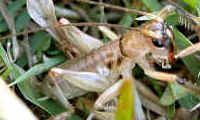 Name : Striped Raspy Cricket - Paragryllacris
combusta, nymph
Name : Striped Raspy Cricket - Paragryllacris
combusta, nymph
- Size: body length 20 - 40mm
- Habitat: gardens and backyards
- Habits : active at night, nests in holes on trees and
between the leaf-sheaths of plants
- We found them at : our backyard, Eight Mile Plains
- Identification : dark brown colour, long antennae, face
patterns, nymph wingless
-
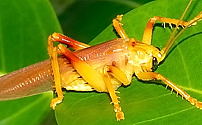 -
Name : Spider Face Leaf-rolling Cricket -
Nunkeria sp.
- Size: body length 50mm
- Habitat: bush, on tree
- Habits : active at night, nests
between the leaves
- We found them at : bush, Wishart
- Identification : Reddish brown to orange brown, long antennae,
spider's face patterns
-
- Family TETTIGONIIDAE - Katydids
- In this family, nymphs are usually resemble ants or bugs. Females have sword-like ovipositor and
lay eggs by inserted them into leaf. Males produce love songs by file on
the left wing and scraper on the right. Most of them are tree foliage feeders. A few of them are predaceous species.
-
 Name : Blackish Meadow
Katydid - Conocephalus semivittatus, male
Name : Blackish Meadow
Katydid - Conocephalus semivittatus, male- Size: body length 15mm-20mm
- Habitat: bushland near waters
- Habits : active after evening, hide among tall grasses
- We found them at : Eight Mile Plains and Karawatha Forest
- Identification : pale brown and green in colours, long
antennae, male is winged
-
-
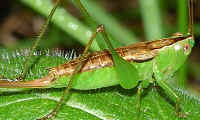 Name : Blackish Meadow
Katydid - Conocephalus semivittatus, female
Name : Blackish Meadow
Katydid - Conocephalus semivittatus, female
- Size: body length 20mm
- Habitat: bushland near waters
- Habits : active after evening, hide among tall grasses
- We found them at : Eight Mile Plains and Karawatha Forest
- Identification : pale brown and green in colours, long
antennae, female is wingless
-
 - Name : Red Meadow Katydid
- ? Conocephalus sp.
- Size: body length 20mm
- Habitat: not known
- Habits : found wondering on tall grasses
- We found them at : once in Wishart bushland
- Identification : reddish brown, long antennae
-
-

- Name : Spine-headed Katydid
- Nicsara sp.
- Size: body length 40mm
- Habitat: Eucalypt forest
- Habits : nests in leaves sheaths
- We found them at : Karawatha Forest
- Identification : spine-headed, brown to dark brown,
-
-
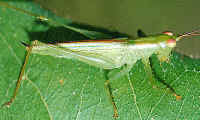
- Name : Diurnal
Predatory Katydid, Swayer - Austrophlugis malidupa
- Size: body length 25mm
- Habitat: Wet bushland
- Habits : predatory,
hunting on plants
- We found them at : Yugarapul
Park
- Identification : green in colour with spiny legs
-
-

- Name : False Leaf Katydid -
Mastigaphoides sp.
- Size: body length 60mm
- Habitat: Rainforest
- Habits : Usually stay on tree top, active at night
- We found them at : Lamington National Park
- Identification :
-
-
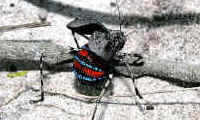
- Name : Mountain Katydid,
Mountain Grasshopper
- Acripeza reticulata, female
- Size: body length 30mm
- Habitat: Rainforest and wet Eucalypt forest
- Habits : slow
moving, display the abdomen when disturbed
- We found them at : Yugarapul Park, Karawatha Forest
- Identification : red and blue colour-banded abdomen
-
-

- Name : Mountain Katydid,
Mountain Grasshopper
- Acripeza reticulata, nymph
- Size: body length 20mm
- Habitat: Rainforest and wet Eucalypt forest
- Habits : slow moving, display the abdomen when disturbed
- We found them at : Yugarapul Park, Karawatha Forest
- Identification : orange colour-banded abdomen
-
-
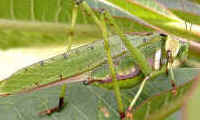
- Name : 32-Spotted Katydid,
Mottled Katydid - Ephippitytha trigintiduoguttata
- Size: body length 65mm
- Habitat: Eucalypt forest, park with large gum trees
- Habits : live on top of gum trees and feed on gum leaves
- We found them at : Karawatha Forest, once in our backyard
- Identification : spots on wings, strong spiny hind legs
-
-
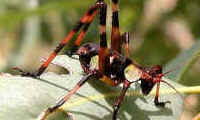
- Name : 32-Spotted Katydid,
Mottled Katydid - Ephippitytha trigintiduoguttata, nymph
- Size: body length 10-60mm
- Habitat: Eucalypt forest, park with large trees
- Habits : live on top of gum trees and feed on gum leaves
- We found them at : Karawatha Forest
- Identification : brown and green patterned body, strong
spiny hind legs
-
-
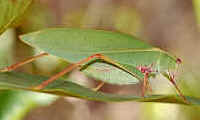
- Name : Gum Leaf Katydid
- Torbia viridissima
- Size: body length 60mm
- Habitat: Eucalypt forest, park with large gum trees
- Habits : Rest among green gum leaves, active at night
- We found them at : common
in Eucalypt forest in Brisbane
- Identification : resemble gum leaf
-
-
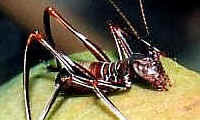
- Name : Gum Leaf Katydid - Torbia
viridissima, nymph
- Size: body length 10-50mm
- Habitat: Eucalypt forest, park with large gum trees
- Habits : found on gum tree trunks, young leaves, mimic
ants when small
- We found them at : common in Eucalypt forest in Brisbane
- Identification : mimic ants when small, turn into brown
with green spots, non-spiny legs
-
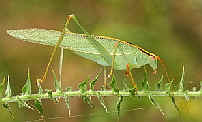 - Name :
Small Gum Leaf Katydid
- ? Caedicia sp.
- Size: body length 35mm
- Habitat: Eucalypt forest
- Habits : Rest among green leaves on trees
- We found them at : Eucalypt forest in Brisbane
- Identification : slander body, green with brown on thorax
-
-
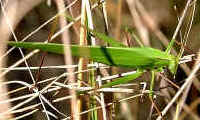
- Name : Small Grassland
Katydid - Polichne sp.
- Size: head to wings tip length 30mm
- Habitat: grasslands in dry Eucalypt forest
- Habits : jump and fly to a few meter away when disturbed
- We found them at : Mt Cotton, Alexandra Hill
- Identification : with
green and brown forms, slander body
-
-

- Name : Small Grassland
Katydid
- Polichne sp.
- Size: head to wings tip length 30mm
- Habitat: grasslands in dry Eucalypt forest
- Habits : jump
and fly to a few meter away when disturbed
- We found them at : Mt Cotton, Alexandra Hill
- Identification : with green and brown forms, slander
body
-
 - Name : Stout-body Katydid
- ? Diastella sp.
- Size: head to wings tip length 35mm
- Habitat: Wet Eucalypt forest
- Habits : jump
and fly to a meter away when disturbed
- We found them at : Ford Road Conservation Area
- Identification : Shorter wings and stout body
-
-
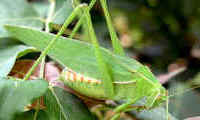
- Name : Common Garden Katydid
- Caedicia simplex
- Size: length 40mm
- Habitat: gardens and backyards with dense vegetations
- Habits : slow moving,
- We found them at : common in Brisbane gardens and parks
- Identification : abdomen with yellow and pink colours
-
-
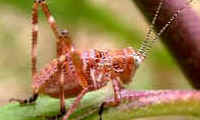
- Name : Common Garden Katydid
- Caedicia simplex, nymph
- Size: length 10-30mm
- Habitat: gardens and backyards with dense vegetations
- Habits : found on young shots of plants
- We found them at : common in Brisbane gardens and parks
- Identification : with
green and brown forms, body with dotted lines patterns
-
- Family GRYLLIDAE - True Crickets
The True Crickets can be distinguished from others by presence of long ovipositor and long cerci
in females. They are nocturnally active. They live on the ground, can be found
in burrows, crack in soil or amongst leaf litter. Males produce complex love songs by rubbing wings together.
-
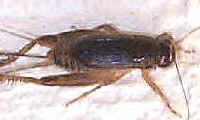
- Name : Slow-chirping Mottled
Field Cricket
- Lepidogryllus comparatus
- Size: body length 25mm
- Habitat: backyards, gardens and road sides
- Habits : male
Field Cricket calling in the hole at night, heading outwards with antenna
outside
- We found them at : very common in Brisbane
- Identification : dark brown in colour, calling sound
-
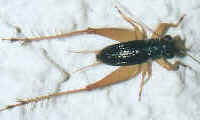 - Name : Silent Leaf-runner
- Metioche vittaticollis
- Size: body length 10mm
- Habitat: details not known
- Habits : active at night
- We found them at : our backyard
- Identification : wingless
or different wing length with shiny dark brown body
-
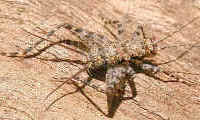 - Name : Spider Cricket - Endotaria
sp.
- Size: body length 20mm
- Habitat: Eucalypt forest
- Habits : hide under rotten wood, active at night
- We found them at : Karawatha Forest
- Identification : both male and female are wingless, long
legs, grey in colour with dark brown patterns
-
-

- Name : Silent Bush Cricket
- Aphonoides angustissimus
- Size: body length 30mm
- Habitat: Eucalypt forest, rainforest
- Habits : Rest on green leaves during the day
- We found them at : Karawatha Forest
- Identification : do not have the stridulatory apparatus,
-
 - Name : Scale Cricket
- Ornebius sp.,
female
- Size: body length 30mm
- Habitat: usually found hiding under loosen bark of gum
tree
- Habits : details not known
- We found them at : Karawatha Forest, Ford Road Reserve
Area
- Identification : pale brown in colour
-
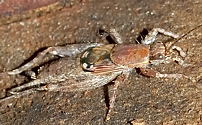
- Name : Scale Cricket
- Ornebius sp.,
male
- Size: body length 30mm
- Habitat: usually found hiding under loosen bark of gum
tree
- Habits : details not known
- We found them at : Karawatha Forest, Ford Road Reserve
Area
- Identification : pale brown in colour, with patterned
small wings
-
- Family GRYLLOTALPIDAE -
Mole Crickets
Mole Crickets have characteristic digging forelegs. Males produce songs and build burrows to amplify
their love song. When dug up, they do not leap away like other
burrow-inhabiting insects but dig their way back underground with powerful strokes of the forelegs. The dirt is simply forced
aside.
-
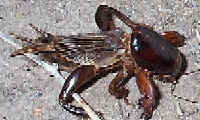 - Name : Common Mole Cricket
- Gryllotalpa pluvialis, female
- Size: body length 50mm
- Habitat: Gardens and backyards
- Habits : sings loudly in the wet summer night
- We found them at : very common in Brisbane
- Identification : shiny
dark brown in colour, large body size, wings longer than male
-
-

- Name : Common Mole Cricket
- Gryllotalpa pluvialis, male
- Size: body length 50mm
- Habitat: Gardens and backyards
- Habits : wandering around look for the singing male
during the summer night
- We found them at : very common in Brisbane
- Identification : shiny dark brown in colour, large body
size, recognize by their song
-
-
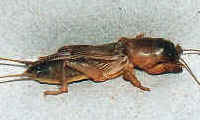
- Name : Dark Night Mole
Cricket
- Gryllotalpa monanka, male
- Size: body length 35mm
- Habitat: Gardens and backyards
- Habits : sings
after dark for half an hour
- We found them at : common in Brisbane
- Identification : dull brown in colour, medium body size, recognize
by their song
-
-
- Suborder Caelifera
This suborder includes the short-horned grasshoppers, grasshoppers and locust.
Members in this suborder have their antennae not very long. Most species feed on grass and low bushes.
The auditory organs are on the first segment of their abdomen. They produce
their love song, the stridulation, by lateral part of their forewings. Females normally larger than males
and with short ovipositors.
-
- Family EUMASTACIDAE - Morabine
Grasshoppers
Most members in this family are wingless. They are usually very elongated and
narrow. They are well camouflaged and hide in the plants.
-
 - Name : Matchstick -
?sp.
- Size: body length 35mm
- Habitat: details not known
- Habits : slow moving, rest on green leaf during the day
- We found them at : Karawatha Forest, Lake Wivenhoe,
Alexandra Hill
- Identification : Most members in this family are wingless,
very elongated and narrow body
-
- Family PYRGOMORPHIDAE - Pyrgomorphs
- This family is very close related with the Family ACRIDIDAE
and sometimes put under ACRIDIDAE as the subfamily. They are medium in size.
Usually they hide in grasses, not quite jump or fly. Protection simply relies on
their camouflage colour.
-
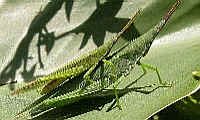 - Name : Northern Grass Pyrgimorph
- Atractomorpha similis or Atractomorpha australis
- Size: length 40mm and 30mm
- Habitat: low plants in gardens and backyards
- Habits : slow moving
- We found them at : very common in Brisbane
- Identification : pink colour on their hind wings and
abdomen, cone head
-
- Family ACRIDIDAE - Typical Grasshoppers
-
Members in this family usually have their wings well developed and sometimes brightly
coloured. Most of them have an annual life cycle. Some species, under some
conditions, will migrate in a dense swarms form, known as locusts.
-

- Name : Creek Grasshopper
- Bermius odontocercus or Bermius brachycerus
- Size: body length 30mm
- Habitat: on
grasses and sedges next to fresh waters
- Habits : feed on sedges
during the day, jump on to water if disturbed
- We found them at : Bulimba Creek in Yugarapul
Park, lagoon in Karawatha Forest
- Identification : green in colour with black strips on
both sides of the body
-
-
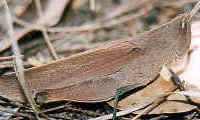
- Name : Mimetic Gumleaf
Grasshopper
- Goniaea opomaloides
- Size: body length 40mm
- Habitat: Eucalypt forest
- Habits : usually rest on ground among dry gum leaves
- We found them at : Alexandra Hill, White Hill
- Identification : medium in size, pale brown in colour,
bluish-purple hind tibiae
-
-
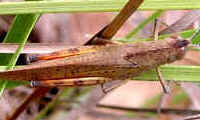
- Name : Black-kneed Gumleaf
Grasshopper
- Goniaea carinata
- Size: body length 40mm
- Habitat: Eucalypt forest
- Habits : rest on ground and low vegetations
- We found them at : Mt Cotton
- Identification : bright yellow-orange hind wings, longer
antenna with white tips
-
-

- Name : Slender Gumleaf
Grasshopper
- Goniaea vocans
- Size: body length 60mm
- Habitat: Eucalypt forest
- Habits : rest on the ground with the dry gum tree leaves
- We found them at : Alexander Hill
- Identification : large in side, the top edge of thorax,
lower and less pronounced, and has a distinct cut
-
-

- Name : Gumleaf Grasshopper
- Goniaea australasiae
- Size: adult body length 50mm
- Habitat: Eucalypt forest
- Habits : rest on the ground or gum tree stems
- We found them at : Mt Cotton
- Identification : large
in side, the top edge of thorax pronounced
-
-
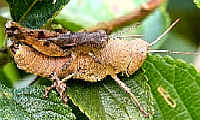
- Name : Bicoloured Cedarinia
- Cedarinia sp.
- Size: body length female 35mm, male 20mm
- Habitat: Bushland
- Habits : rest on green leaves of low plants
- We found them at : Bushland in Macgregor near Bulimba
Creek
- Identification : female is pale brown, male is
darker in colour, both have very tiny wings
-
-
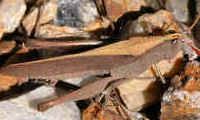
- Name : Epallia Grasshopper
- Epallia exigua
- Size: body length 40mm
- Habitat: Eucalypt forest
- Habits : rest on the ground
- We found them at : Alexander Hill
- Identification : pale brown colour with flatten back
-
 - Name : Short-winged Heath
Grasshopper
- ? Rhitzala modesta
- Size: body length 20mm
- Habitat: Eucalypt forest
- Habits : details not known
- We found them at : Karawatha Forest
- Identification : short-winged, bright orange colour on
hind legs
-
-

- Name : Queensland White-tips
- Rectitropis australis
- Size: body length 20mm
- Habitat: Eucalypt forest
- Habits : rest on ground with dry leaves
- We found them at : Mt Cotton, Karawatha Forest, Alexandra
Hill
- Identification : short winged, inner hind legs black in
colour, white rings near the tip of antennae
-
-
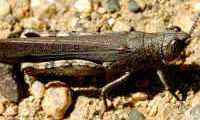
- Name : Common Pardillana
- Pardillana limbata
- Size: body length 60mm
- Habitat: Eucalypt forest
- Habits : mostly found resting on tree trunks and stems,
also found on ground
- We found them at : Karawatha Forest
- Identification : body
colours from orange brown to dark brown, with large compound eyes
-
-

- Name : Stem Grasshopper, Common
Adreppus
- Adreppus fallax
- Size: body length 40mm
- Habitat: Eucalypt forest
- Habits : rest on tree trunks and stems with rough bark
surface
- We found them at : Karawatha Forest, common in Brisbane
bushland
- Identification : large compound eyes, relatively long
antennae
-
-

- Name : Bark-Mimicking Grasshopper
- Coryphistes ruricola
- Size: body length 40mm
- Habitat: Eucalypt forest
- Habits : rest on tree trunks or fallen barks on ground
- We found them at : Alexandra Hill, Karawatha Forest
- Identification : elongated antennae in sword shape and
flattened at the bases
-
-

- Name : Handsome Macrotona Grasshopper
- Macrotona mjoebergi
- Size: body length 30mm
- Habitat: Eucalypt forest associated with Spinifex grass Triodia
- Habits : rest
on ground
- We found them at : Alexandra Hill
- Identification : black with white strips from head to
wing tip, antennae short with flattened tip
-
-
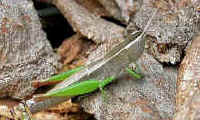
- Name : Green-legs Wingless
Grasshopper, False Perloccia
- Maclystria sp.
- Size: body length female 30mm
male 15mm
- Habitat: Eucalypt forest
- Habits : details not known
- We found them at : Karawatha Forest
- Identification : three pair of green legs
-
-
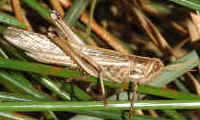
- Name : Spur-throated Locust
- Austracris proxima
- Size: body length 60mm
- Habitat: Bushland
- Habits : forms swarms and can reach plague status in
Australia
- We found them at : a lagoon in Karawatha forest
- Identification :
-
-
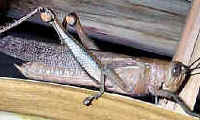
- Name : Giant
Grasshopper, Giant Valanga
- Valanga irregularis
- Size: body length 90mm, largest
grasshopper in Brisbane
- Habitat: gardens and backyards
- Habits : feed on green leaves during the day
- We found them at : very common in Brisbane
- Identification : large in size, body colour vary between individual
-
-

- Name : Froggatt's Buzzer
- Froggattina australis
- Size: body length 25mm
- Habitat: bushland
- Habits : flies with loud buzzing sound
- We found them at : common on grassland
- Identification : green grasshopper flies with loud
buzzing sound
-
-

- Name : Golden Bandwing
- Cryptobothrus chrysophorus
- Size: body length 20mm
- Habitat: Eucalypt forest
- Habits : rest on dry leaves on ground, male produces a
buzzing sound when flight
- We found them at : Karawatha Forest, Alexandra Hill
- Identification : abdomen and hind legs are bright orange
in colour
-
-
|
 Name : Striped Raspy Cricket
- Paragryllacris combusta, female (male look about the same)
Name : Striped Raspy Cricket
- Paragryllacris combusta, female (male look about the same)
 Name : Striped Raspy Cricket - Paragryllacris
combusta, nymph
Name : Striped Raspy Cricket - Paragryllacris
combusta, nymph
 Name : Blackish Meadow
Katydid - Conocephalus semivittatus, male
Name : Blackish Meadow
Katydid - Conocephalus semivittatus, male Name : Blackish Meadow
Katydid - Conocephalus semivittatus, female
Name : Blackish Meadow
Katydid - Conocephalus semivittatus, female











































